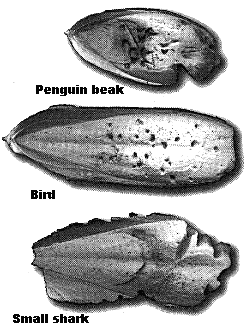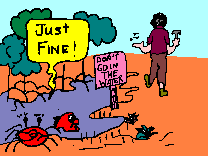Theme: Celebrate the Sea: Clean Oceans
Seaweek '98 coordinator: Barbara Jensen
Sample Materials from the Seaweek '98 kits
Seaweek Primary Activity Booklet This activity is one from the Seaweek'98 Primary Activity booklet. There is background information and activities in outline form. Each activity explores the issues of 'Clean Oceans' or helps celebrate the sea. The booklet is printed by Scholastic Australia.
The Primary and Secondary booklets, along with a new community section and other fact sheets, posters and information flyers make up the Seaweek Educational Kit.
Cuttlefish Detectives Have you ever found a 'cuttlefish bone' on the beach? These lightweight skeletons are part of a cuttlefish. Cuttlefish are relatives of octopus and squid. They are 'intelligent' hunters. They can change colour to match their surroundings and slowly approach prey before catching it with their arms.

Cuttlefish make tasty meals for fish, penguins, dolphins, sea lions and seals. Many are eaten. Most predators do not eat the skeleton and release it to float on the surface of the sea. When a Cuttlefish dies the body rots away or is eaten and skeleton floats to the surface and is often washed up.
Some people collect them for birds to peck at. What most people do not notice is that about one in every five or ten cuttlefish bones have been imprinted with the teeth or beak of the animal that ate it.
Next time you visit an ocean beach look carefully at all the cuttlefish bones you can see and try to figure out what creature caught them.
Seaweek Secondary Activity Booklet

This activity is one from the Seaweek Secondary Activity Booklet which aims to make the connection between catchments and oceans and to provide activities that will develop appropriate strategies for individuals to act towards minimising their impact.
There is background information with activities and resource lists.
Preventing and Managing Oil Spills No matter how much legislation and policy is in place oil spills will continue to occur. Therefore systems need to be in place to limit the intensity and damage from any spill.
Australia has a National Plan to Combat Pollution of the sea. This is a national integrated government and industry organisational framework for responding to oil pollution incidents in the marine environment.
The objectives of the National Plan are based on Australia's responsibility to protect natural and artificial environments from the adverse effects of oil pollution and minimise those effects where protection is not, or has not been possible.
The Australian Maritime Safety Authority (AMSA) administers the National Plan, supported by the Australian Marine Oil Spill Centre, State/NT Governments, and the shipping, petroleum and exploration industries.
The Australian Marine Oil Spill Centre (AMOSC) in Geelong, Victoria has the capability to respond to all industry spills and to assist government in responding to spills around Australia.
AMOSC was established in 1990 to provide the equipment and training in order to respond to major oil spills off Australia's coast. This is a subsidiary company of the Australian Institute of Petroleum.
The National Plan is implemented through effective co-ordination of relevant organisations, efficient and strategically located oil spill combat equipment and training. The Plan incorporates State and Local contingency plans developed for particular sites; for example, TORRESPLAN is developed specifically for Torres Strait.
The Plan utilises a variety of means to bring about an effective response to oil spills. Some of these means include:
- an On Scene Spill Model computer simulation that predicts the movement of oil spills using the prevailing weather conditions;
- the use registers of specific equipment and their locations;
- in addition a Coastal Resource Atlas has been developed with each State and the Northern Territory that identifies sensitive areas with high priority for protection.
The National Plan is funded through the principle that the 'potential polluter pays' and as a result, a small levy is imposed on commercial shipping operators using Australian ports.
No two spills are the same and often a combination of management approaches will be used. AMSA and AMOSC implement the following methods.
- Leave the spill alone but monitor if the oil is at sea and poses no threat to coastal areas. The natural processes of dispersion and biodegradation through the action of wind, sun, waves and currents eventually destroy the spill.
- Use dispersants to break up the oil. Dispersants act by reducing the surface tension that stops oil and water from mixing. The oil then forms into small particles that are dispersed through the water column increasing the rate of biodegradation.
- Contain and recover the oil through the use of booms and skimmers. A physical barrier or boom is used to contain or to divert the flow. An absorbent material can then be added such as peat, cotton, wool or pine bark which may absorb up to 20 times its own weight. However, these procedures are sometimes limited by the prevailing weather conditions.
- Introduce biological agents to hasten biodegradation is called bioremediation. These agents include bacteria and other micro-organisms that occur naturally in oceans. Fertilisers can also be applied to the spill to stimulate bacterial growth and hasten biodegradation.
Source: International Petroleum Industry Environmental Conservation Association. "A Guide to Contingency Planning for Oil Spills on Water."
- Recent oil spills
- Map their location.
- Determine if there are any 'hotspots'.
- What were the conditions that allowed the spill to occur, for example weather and condition of vessel.
- How were these spills managed?
- Who was involved and how?
- What was the impact of the spills?
- What suggestions can you make to minimise the impact of the spill?
- Map the protected area in and around the Great Barrier Reef Marine Park (GBRMP).
- Research major shipping routes.
- Is there any correlation between these two areas?
- Has there been any oil spills in this area?
- What impact did they cause?
- What other activities threaten the waters around the GBRMP?
- What suggestions can you make to minimise the impact of the spill?
- What plans are in place to prevent spills?
- Bioremediaton requires the use of oil microbes to neutralise the effect of oil.
- How does the process work?
- What recent spills used bioremediation?
- What microbes are used?
- What are the constraints and advantages of using microbes?
- Develop an experiment to illustrate how dispersants work.
- Design and make other methods for dealing with oil spills.
- The laws enacted under the international convention MARPOL 73/78 may be a wide reaching. But, can you think of any additional annexes that may need to be included now and in the future?
Additional and up-to-date information concerning legislation and managing oil spills can be obtained by contacting the AMSA through:
National Plan; Australia's National Plan to Combat Pollution of the Sea by Oil. AMSA
|